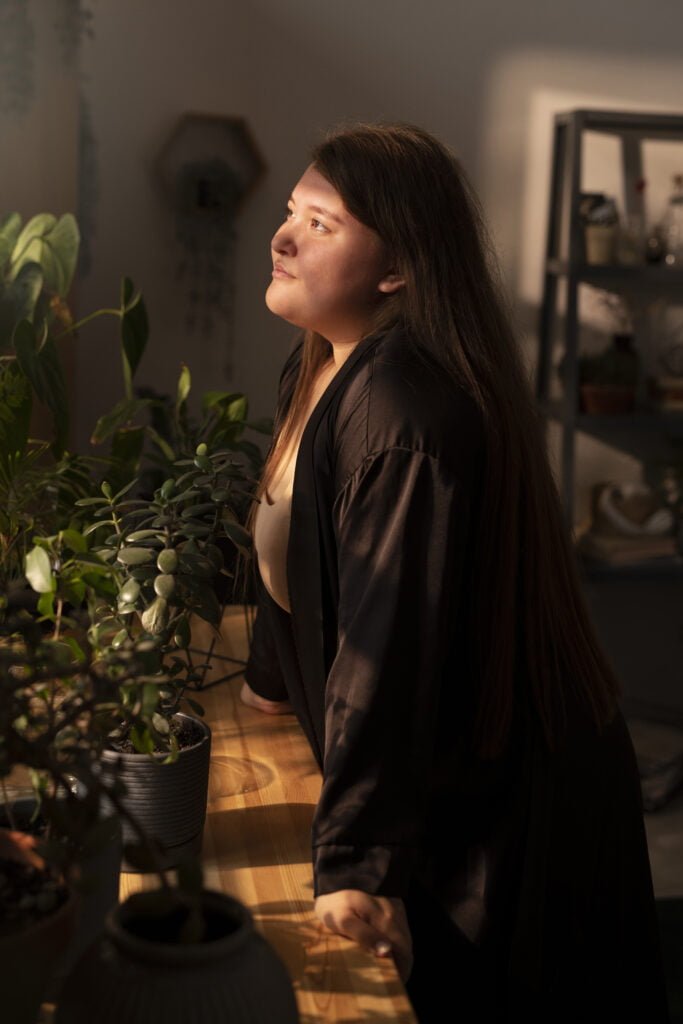In our demanding and often critical world, cultivating self-love can be a challenging task and yet it is more important than ever. Visualization techniques offer a powerful, accessible way to nurture a deeper sense of self-acceptance and love. This post explains how to harness the power of visualization to transform your relationship with yourself, boost your overall well-being, and create lasting positive change in your life.
Understanding Visualization and Self-Love
Visualization is a mental technique that involves creating vivid, detailed images in your mind to achieve specific goals. When applied to self-love, visualization becomes a tool for rewiring our brain to embrace a more positive self-image. Dr. Maxwell Maltz, author of the groundbreaking book “Psycho-Cybernetics,” emphasized the importance of self-image, stating,
“The ‘self-image’ is the key to human personality and human behavior. Change the self-image and you change the personality and the behavior.”
Self-love, on the other hand, is the practice of valuing and caring for oneself. It encompasses self-acceptance, self-respect, and a deep appreciation for who we are, flaws and all. When we combine visualization techniques to enhance self-love, we create a powerful synergy that can lead to profound personal growth.

The Benefits of Visualizing Self-Love
Before diving into specific techniques, it’s important to understand the numerous benefits that come from
- Increased self-esteem – Regular visualization can help boost your confidence and self-worth.
- Reduced anxiety and stress – By focusing on positive self-images, you can lower stress levels and alleviate anxiety.
- Improved emotional resilience – Visualizing self-love scenarios can help you bounce back from setbacks more easily.
- Enhanced overall well-being – A stronger sense of self-love contributes to better mental and physical health.
- Stronger relationships with others – When you love yourself, you’re better equipped to form healthy, loving relationships with others.
- Increased motivation and goal achievement – Self-love visualization can fuel your drive to pursue and achieve your goals.
- Improved body image – Visualization techniques can help foster a more positive relationship with your body.
- Greater self-awareness – Visualising often leads to deeper self-understanding and insight.
Practical Visualization Techniques for Self-Love
Now that we understand the benefits, let’s explore some practical visualization techniques you can use to enhance self-love:
Mirror Affirmations
This powerful technique combines visual and verbal elements to reinforce positive self-perceptions.
How to practice:
- Stand in front of a mirror.
- Visualize yourself surrounded by a warm, loving light.
- Make eye contact with your reflection and repeat positive affirmations.
Examples of affirmations:
- “I am worthy of love and respect.”
- “I embrace all aspects of myself.”
- “I am enough, just as I am.”
- “I love and accept myself unconditionally.”
The ego or inner critic might resist, saying, “This is silly. You’re just lying to yourself.” Acknowledge these thoughts, then gently refocus on the affirmations. Remember, you’re working to create new neural pathways, and persistence is key.
Future Self Visualization
This technique involves projecting yourself into a future where you’ve achieved a deep sense of self-love.
How to practice:
- Find a quiet, comfortable space and close your eyes.
- Imagine yourself in the future, having fully embraced self-love.
- Visualize in detail – How do you carry yourself? How do you treat yourself and others? What does your life look like?
- Engage all your senses in this visualization. What do you see, hear, feel, smell, and taste in this future scenario?
This practice not only helps you envision a more loving relationship with yourself but also provides a roadmap for personal growth.
Loving-Kindness Meditation
This Buddhist-inspired practice cultivates feelings of love and compassion, starting with oneself and extending to others.
How to practice:
- Sit comfortably and close your eyes.
- Picture yourself in your mind’s eye.
- Send feelings of love, compassion, and acceptance to this image of yourself.
- Repeat phrases such as:
“May I be happy.”
“May I be healthy.”
“May I be at peace.”
“May I love myself fully.”
As you become comfortable with this practice, you can extend these well-wishes to loved ones, acquaintances, and eventually all beings.
Healing Light Visualization
This technique uses the metaphor of light to represent healing and self-love.
How to practice:
- Lie down or sit comfortably and close your eyes.
- Imagine a warm, healing light entering your body.
- Visualize this light filling you with warmth, love, and acceptance.
- See the light dissolving any negative self-perceptions or self-doubt.
- Imagine the light radiating from within you, surrounding you with a protective, loving glow.
Body Appreciation Visualization
This practice helps foster a more loving relationship with your body.
How to practice:
- Lie down and close your eyes.
- Mentally scan your body from head to toe.
- As you focus on each part, visualize sending it love and appreciation.
- Acknowledge the function and importance of each body part.
- Express gratitude for your body’s abilities and resilience.
Success Visualization
This technique involves visualizing yourself succeeding in various aspects of life, reinforcing your capability and worth.
How to practice:
- Choose a goal or challenge you’re facing.
- Close your eyes and vividly imagine yourself successfully achieving this goal.
- Visualize the process, the outcome, and how you feel having accomplished it.
- Focus on the sense of pride, self-respect, and love you feel for yourself in this scenario.

Inner Child Visualization
This powerful technique involves nurturing your inner child, addressing past hurts, and fostering self-compassion.
How to practice:
- Close your eyes and visualize yourself as a child.
- Imagine approaching this younger version of yourself with love and compassion.
- Visualize hugging your inner child, offering comfort and reassurance.
- Tell your inner child the things you needed to hear when you were young.
Integrating Visualization into Daily Life
Consistency is key when using visualization techniques. Here are some tips to incorporate them into your routine:
- Set aside 5-10 minutes each day for visualization practice. Consistency is more important than duration.
- Use visual aids like photos or vision boards to enhance your practice. These can serve as powerful reminders and focusing tools.
- Combine visualization with other self-care activities. For example, practice body appreciation visualization during your skincare routine, or do a future self-visualization while exercising.
- Practice mindfulness throughout the day to stay connected with your visualizations. This helps bridge the gap between your visualization practice and daily life.
- Use triggers or anchors to remind you of your visualizations. For instance, every time you see your reflection, it could trigger a quick loving-kindness meditation.
- Journal about your visualization experiences. This can help deepen your understanding and track your progress over time.
- Create a dedicated space for your visualization practice. This could be a corner of your room with comfortable cushions and inspiring imagery.
- Use guided visualization recordings. There are many available online, or you could create your own.
Overcoming Challenges in Visualization
It’s normal to encounter resistance or difficulty when starting a visualization practice. The inner critic might say, “This isn’t working. You’re wasting your time.” Here are some strategies to overcome common challenges:
- Start small – Begin with short, simple visualizations and gradually increase complexity and duration.
- Be patient – Like any skill, visualization improves with practice. Don’t expect perfection from the start.
- Address resistance – If you encounter internal resistance, acknowledge it without judgment. Then gently return to your practice.
- Use all your senses – If visual imagery is challenging, focus on other senses in your visualizations.
- Be flexible – If one technique doesn’t resonate with you, try another. There’s no one-size-fits-all approach to visualization.
- Practice self-compassion – If you miss a day or struggle with your practice, respond with kindness rather than criticism.
- Seek support – Consider working with a coach or therapist who can guide you through visualization techniques.

The Science Behind Visualization and Self-Love
Research supports the effectiveness of visualization techniques in various areas of life, including self-perception and emotional well-being.
A study published in the Journal of Cognitive Psychology found that mental imagery can significantly influence emotions and behaviour. By consistently visualizing self-love scenarios, we can create new neural pathways that support a more positive self-image.
Neuroscientific research has shown that visualization activates many of the same neural networks as actually performing an action. This suggests that when we visualize loving ourselves, our brain responds similarly to actually experiencing self-love.
Psychologist Dr. Kristin Neff, a leading researcher on self-compassion, notes,
“With self-compassion, we give ourselves the same kindness and care we’d give to a good friend.”
Visualization techniques can help us embody this self-compassionate attitude, making it easier to treat ourselves with kindness and understanding.
Moreover, studies on loving-kindness meditation, a form of visualization, have shown improvements in positive emotions, life satisfaction, and depression symptoms. This underscores the potential of visualization techniques to enhance overall well-being and self-love.
Practical Tips for Enhancing Your Visualization Practice
- Create a visualization routine – Set a specific time each day for your practice. This could be first thing in the morning, during your lunch break, or before bed.
- Use progressive muscle relaxation before visualizing – This can help you enter a more relaxed state, making visualization easier and more effective.
- Engage your emotions – Don’t just see the images; feel the emotions associated with them. The more you can engage your emotions, the more powerful your visualizations will be.
- Be specific and detailed – The more vivid and detailed your visualizations, the more impact they’ll have. Engage all your senses.
- Use positive language – Frame your visualizations and affirmations positively. Instead of “I am not self-critical,” use “I am kind and accepting of myself.”
- Combine visualization with physical actions – For example, while visualizing self-love, you could place your hand on your heart. This physical anchor can make the visualization more powerful.
- Stay present-focused – While it’s fine to visualize future scenarios, make sure to also visualize loving yourself as you are right now.
- Practice gratitude – Incorporate gratitude into your visualizations. Visualize thanking your body, mind, and spirit for all they do for you.
- Use music or nature sounds – Background sounds can enhance your visualization experience and help you relax more deeply.
- Be consistent but flexible – While consistency is important, don’t be rigid. If you miss a day, simply return to your practice without self-judgment.
Addressing the Inner Critic
As you embark on this journey of self-love visualization, you may encounter resistance from your inner critic or ego. This voice might say things like:
- “This is a waste of time. You have more important things to do.”
- “You don’t deserve love. Who are you kidding?”
- “This feels fake. You’re just pretending to love yourself.”
It’s crucial to remember that this inner critic is not your true self. It’s a protective mechanism that, while well-intentioned, often holds us back from growth and self-acceptance. Here’s how to address these critical thoughts:
- Acknowledge them – Recognize these thoughts without judgment. Say to yourself, “I hear you, inner critic.”
- Thank them – Paradoxically, thanking your inner critic can disarm it. “Thank you for trying to protect me, but I choose to love myself.”
- Reframe – Transform critical thoughts into more loving ones. “I’m not wasting time; I’m investing in my well-being.”
- Visualize dialogue – Imagine that you have a conversation with your inner critic, responding with compassion and firmness.
- Use the “observer” technique — Visualize yourself stepping back and observing these thoughts, rather than identifying with them.
Remember, the goal isn’t to eliminate the inner critic entirely, but to develop a healthier relationship with it and to strengthen the voice of self-love.
Conclusion
Visualization is a powerful tool for enhancing self-love and overall well-being. By consistently practising these techniques, we can reshape our self-perception and cultivate a deeper sense of self-acceptance. Remember, the journey to self-love is ongoing, and each visualization is a step towards a more loving relationship with yourself.
As you embark on this journey, be patient and compassionate with yourself. The path to self-love may have challenges, but with dedication and practice, you can create lasting positive change in your life. Embrace the power of your mind to nurture a loving relationship with yourself, and watch as this love transforms not only your inner world but your outer experiences as well.
In the words of Louise Hay, a pioneer in the self-help movement,
“You have been criticizing yourself for years, and it hasn’t worked. Try approving of yourself and see what happens.”
Through visualization, you have the tools to approve of, accept, and deeply love yourself.

Ready to Take Your Self-Love Journey to the Next Level?
While self-guided visualization practices are incredibly powerful, sometimes we all need a little extra support and guidance. If you’re feeling called to dive deeper into self-love work and want personalized strategies tailored to your unique journey, I invite you to consider booking an individual session with me.
In our one-on-one sessions, we’ll work together to:
- Identify any blocks or resistances to self-love in your life
- Develop customized visualization techniques that resonate with you
- Address your inner critic with compassion and firmness
- Create a sustainable self-love practice that fits your lifestyle
- Explore advanced visualization techniques for profound personal growth
Whether you’re just starting your self-love journey or looking to deepen your existing practice, individual sessions can provide focused attention and expert guidance to help you flourish.
To book a session or learn more about how we can work together, please click the button below:
Let’s embark on this transformative journey together and unlock the full potential of self-love in your life.
Remember, you deserve love, and that love starts with you. Take this step towards a more loving relationship with yourself today.




